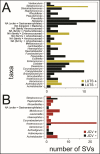A multi-omic investigation of male lower urinary tract symptoms: Potential role for JC virus
- PMID: 33630889
- PMCID: PMC7906371
- DOI: 10.1371/journal.pone.0246266
A multi-omic investigation of male lower urinary tract symptoms: Potential role for JC virus
Abstract
Male lower urinary tract symptoms (LUTS) comprise a common syndrome of aging that negatively impacts quality of life. The etiology of LUTS is multifactorial, involving benign prostatic hyperplasia, smooth muscle and neurologic dysfunction, inflammation, sexually transmitted infections, fibrosis, and potentially dysbiosis, but this aspect remains poorly explored. We investigated whether the presence of infectious agents in urine might be associated with LUTS by combining next-generation DNA sequencing for virus discovery, microbiome analysis for characterization of bacterial communities, and mass spectrometry-based metabolomics. In urine from 29 LUTS cases and 9 controls from Wisconsin, we found a statistically significant association between a diagnosis of LUTS and the presence of JC virus (JCV), a common neurotropic human polyomavirus (Polyomaviridae, Betapolyomavirus) linked to severe neurologic disease in rare cases. This association (based on metagenomics) was not borne out when specific polymerase chain reaction (PCR) testing was applied to this set of samples, likely due to the greater sensitivity of PCR. Interestingly, urine metabolomics analysis identified dysregulation of metabolites associated with key LUTS processes. Microbiome analysis found no evidence of microbial community dysbiosis in LUTS cases, but JCV-positive samples contained more Anaerococcus species, which are involved in polymicrobial infections of the urinary tract. Neither age nor body mass index were significantly associated with the presence of urinary JCV-in the initial group or in an additional, regionally distinct group. These data provide preliminary support the hypothesis that viruses such as JCV may play a role in the development or progression of LUTS, together with other infectious agents and host metabolic responses.
Conflict of interest statement
The authors have declared that no competing interests exist.
Figures




Similar articles
-
Detection of BK virus and JC virus DNA in urine samples from immunocompromised (HIV-infected) and immunocompetent (HIV-non-infected) patients using polymerase chain reaction and microplate hybridisation.J Clin Virol. 2004 Apr;29(4):224-9. doi: 10.1016/S1386-6532(03)00155-0. J Clin Virol. 2004. PMID: 15018849
-
New commercially available PCR and microplate hybridization assay for detection and differentiation of human polyomaviruses JC and BK in cerebrospinal fluid, serum, and urine samples.J Clin Microbiol. 2006 Apr;44(4):1305-9. doi: 10.1128/JCM.44.4.1305-1309.2006. J Clin Microbiol. 2006. PMID: 16597855 Free PMC article.
-
Association between the JC polyomavirus infection and male infertility.PLoS One. 2012;7(8):e42880. doi: 10.1371/journal.pone.0042880. Epub 2012 Aug 13. PLoS One. 2012. PMID: 22912758 Free PMC article.
-
EAU Guidelines on the Assessment of Non-neurogenic Male Lower Urinary Tract Symptoms including Benign Prostatic Obstruction.Eur Urol. 2015 Jun;67(6):1099-1109. doi: 10.1016/j.eururo.2014.12.038. Epub 2015 Jan 19. Eur Urol. 2015. PMID: 25613154 Review.
-
JC virus-associated nephropathy in a renal transplant recipient and comparative analysis of previous cases.Transpl Infect Dis. 2011 Feb;13(1):89-92. doi: 10.1111/j.1399-3062.2010.00567.x. Epub 2010 Sep 6. Transpl Infect Dis. 2011. PMID: 21299772 Review.
Cited by
-
The oncogenic roles of JC polyomavirus in cancer.Front Oncol. 2022 Sep 23;12:976577. doi: 10.3389/fonc.2022.976577. eCollection 2022. Front Oncol. 2022. PMID: 36212474 Free PMC article. Review.
-
Intrinsic and extrinsic factors causing hyperplasia of the prostate.Int J Urol. 2024 Jul;31(7):705-717. doi: 10.1111/iju.15446. Epub 2024 Mar 10. Int J Urol. 2024. PMID: 38462732 Free PMC article. Review.
-
Relationship between the risk of atherosclerotic cardiovascular disease and decreased functional bladder capacity.Int Urol Nephrol. 2024 Oct 23. doi: 10.1007/s11255-024-04241-z. Online ahead of print. Int Urol Nephrol. 2024. PMID: 39443430
-
Urinary microbiota and prostatic diseases: the key for the lock? A systematic review.Prostate Cancer Prostatic Dis. 2023 Sep;26(3):451-460. doi: 10.1038/s41391-022-00602-w. Epub 2022 Oct 8. Prostate Cancer Prostatic Dis. 2023. PMID: 36209236 Review.
-
Dysbiosis of the Human Urinary Microbiome and its Association to Diseases Affecting the Urinary System.Indian J Microbiol. 2022 Jun;62(2):153-166. doi: 10.1007/s12088-021-00991-x. Epub 2021 Nov 16. Indian J Microbiol. 2022. PMID: 35462710 Free PMC article. Review.
References
Publication types
MeSH terms
Grants and funding
LinkOut - more resources
Full Text Sources
Other Literature Sources
Medical

